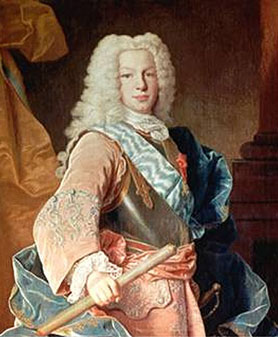Today in Social Sciences we have reviewed what we studied the previous class about the Spanish Succession War.
We have reviewed about the development of the war and when the Emperor of Austia died, the Archduke Charles became Emperor.
The Archduke was supported by the Crown of Aragón.
Finally every sides looked for an international agreement to end the war and they signed the Treaty of Utrecht.
http://www.laalcazaba.org/wp-content/uploads/2012/09/Archiduque-Carlos-Palacio-Real-mMdrid.jpg
The Treaty of Utrecht said:
- Philip V was the king.
- The European territories of the Hispanic Monarchy were distributed among Austria and Savoy.
- Philip V lost his right to the French crown.
https://upload.wikimedia.org/wikipedia/commons/thumb/1/1a/The_Treaty_of_Utrecht_(clean).jpg/200px-The_Treaty_of_Utrecht_(clean).jpg
Today we have also learn about the centralized Absolutism.
Philip V was the father of Ferdinand VI, both of them with mental problems, but this didn't interfere in government.
Philip V was a bipolar king, he had a lot of mood changes; one moment he was euphoric and at other moment he had remorses and went tothe priest to confess.
https://upload.wikimedia.org/wikipedia/commons/9/97/Felipe_V_de_Espa%C3%B1a.jpg
A lot of changes took places during his reign:
- Punishment to the Crown of Aragón; all they institutions disapperared, they lost the Crown and the Cortes of Aragón disappeared, the unique contribution was a tax of 5% tax everybody from the former Crown of Aragón had to pay.
- The Cortes of Castile became the Cortes of Spain.
- Corregidores were extended to Aragón.
- Intendants, an institution of French origin with tax collection and mmilitary powers
- The country was divided into 21 provinces during his government.
- Also the cabinet appeared.
http://globedia.com/imagenes/noticias/2014/6/4/cuadro-rey-felipe-cuelga-cabeza-abajo-museo-almudin-jativa_1_2090557.jpg
Philip decide to adicate in favour of his first son Louis I who only reigned for 6th months.
When Louis died, Philip was forced to return to the throne.
When he died in 1746, his second son, Ferdinand VI became king.
Ferdinand only reigned for 31 years.
He (normally) was a normal peerson but when his wife died, he became crazy.
http://www.nndb.com/people/932/000097641/ferdinand-vi-2-sized.jpg
During his reign; some competent ministers worked for him like the Marquis of Ensenada and Carvajal.
The Ensenada Cadastre was a project to extend(ed) the unique contribution to Castile, but was rejected by the privileged.
https://upload.wikimedia.org/wikipedia/commons/thumb/d/df/Marqu%C3%A9s_de_la_Ensenada_por_Jouffroy.jpg/250px-Marqu%C3%A9s_de_la_Ensenada_por_Jouffroy.jpg
The Navy was reformed to improve the control of the Indies.
When we died, his half'-brother Charles III became the king.
Charles had been king of Naples for 20 years.
At the beginning of his reign, he had problems in his government.
In 1766 there was a revolt called Esquilache Riots.
This revolt wanted to eliminated the ordinance on clothing and the lowering of staples. The ordinance on clothing was promoted by Esquilache because he thought that is a good way to preventing crimes. But after the riot, the ordinance was eliminated by Charles III.
https://upload.wikimedia.org/wikipedia/commons/2/2d/Charles_III_of_Spain_high_resolution.jpg
Vocabulary:
Mood- estado de ánimo.
Euphoric- euforia
Remorse- remordimientos
Roller-Coaster- montaña rusa.
Contribution- única contribución.
Esquilache Riots- el motín de Esquilache.
Streetlights- farolas.
See you soon!!

.jpg/200px-The_Treaty_of_Utrecht_(clean).jpg)





1 comment:
Hello Anca,
These are my corrections. The content is OK, but there are spelling and word order mistakes. Be careful with this:
Today in Social Sciences we have reviewed what we studied the previous class about the Spanish Succession War.
We have reviewed about the development of the war and when the Emperor of Austria died, the Archduke Charles became Emperor.
The Archduke was supported by the Crown of Aragón.
Finally every side(s) looked for an international agreement to end the war and they signed the Treaty of Utrecht.
• Philip V was the king.
• The European territories of the Hispanic Monarchy were distributed among Austria and Savoy.
• Philip V lost his right to the French crown.
Today we have also learnt about the centralized Absolutism.
Philip V was the father of Ferdinand VI, both of them with mental problems, but this didn't interfere in government.
Philip V was a bipolar king, he had a lot of mood changes; one moment he was euphoric and at other moment he had remorses and went to the priest to confess.
A lot of changes took places during his reign:
• Punishment to the Crown of Aragón; all they institutions disapperared, they lost the Crown and the Cortes of Aragón disappeared,
• the unique contribution was a tax of 5% that everybody from the former Crown of Aragón had to pay.
• The Cortes of Castile became the Cortes of Spain.
• Corregidores were extended to Aragón.
• Intendants, an institution of French origin with tax collection and military powers
• The country was divided into 21 provinces during his government.
• Also the cabinet appeared
During the War of Spanish Succession Philip V burnt the city of Xátiva, so as a form of protest, the citizens accepted to put a painting of him upside down
Philip decide to abdicate in favour of his first son Louis I who only reigned for 6th months.
When Louis died, Philip was forced to return to the throne.
When he died in 1746, his second son, Ferdinand VI became king.
Ferdinand only reigned for 13 years.
He (normally) was a normal peerson but when his wife died, he became crazy.
During his reign; some competent ministers worked for him like the Marquis of Ensenada and Carvajal.
The Ensenada Cadastre was a project to extend(ed) the unique contribution to Castile, but was rejected by the privileged.
The Navy was reformed to improve the control of the Indies.
When we died, his half- brother Charles III became the king.
Charles had been king of Naples for 20 years.
At the beginning of his reign, he had problems in his government.
In 1766 there was a revolt called Esquilache Riots.
This revolt wanted to eliminate(d) the ordinance on clothing and the lowering of staples. The ordinance on clothing was promoted by Esquilache because he thought that it was a good way to preventing crimes. But after the riot, the ordinance was eliminated by Charles III
Vocabulary:
Remorse- remordimientos
Contribution- única contribución.
Esquilache Riots- el motín de Esquilache.
Bye!
Post a Comment